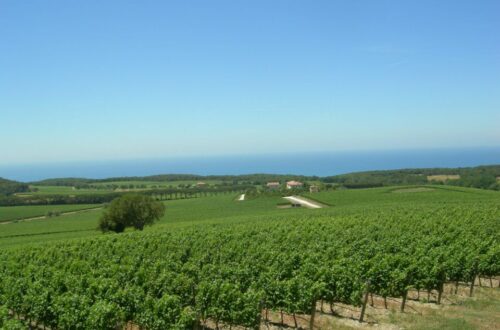Appassimento, Tasting Notes & Buying Guide (2025)A glass of Vin Santo di Carmignano DOC is more than a sweet treat—it’s a distilled memory of Tuscany’s golden light. This Italian dessert wine, long cherished as a vino da meditazione (“meditation wine”), tells a story of patience, craftsmanship, and quiet elegance. Produced in the historic Carmignano wine region using the traditional appassimento aging method, it offers a sensory journey that’s as soulful as it is delicious.
Table of Contents
History & DOC Recognition
Vin Santo’s origins stretch back to the Middle Ages, when monastic cellars refined the art of slow-fermenting dried grapes into a honeyed elixir. The Carmignano DOC designation—granted in 1990—ensures that only wines meeting strict production rules can carry the name, preserving authenticity and quality.
Carmignano Terroir & Climate
The Carmignano zone, just west of Florence, benefits from a Mediterranean climate tempered by Apennine breezes. Warm days encourage sugar concentration in grapes, while cooler nights preserve acidity—crucial for balancing Vin Santo’s sweetness. The region’s limestone and marl soils lend minerality and finesse.
Grape Varieties & Wine Styles
Vin Santo di Carmignano DOC typically blends Trebbiano Toscano and Malvasia Bianca Lunga, occasionally joined by San Colombano. Styles range from amber-gold, nutty, and oxidative to fresher, fruit-forward versions depending on producer philosophy.
Vin Santo Production & DOC Rules
The hallmark of this wine is the appassimento aging method:
- Harvest: Grapes are picked at peak ripeness.
- Drying: Clusters are hung or laid on mats in well-ventilated vinsantaie (attics) for 3–6 months.
- Pressing: The shriveled grapes yield a concentrated must.
- Fermentation & Aging: The must ferments slowly in small oak or chestnut barrels (caratelli), often under the influence of native yeasts, then ages for at least 3 years.
DOC Regulations require a minimum alcohol of 16% and strict grape sourcing from Carmignano.
Tasting Notes & Aromatics
Expect aromas of dried apricot, candied citrus peel, almond, and honey, layered with hints of caramel, baking spice, and dried fig. On the palate, the wine is luscious yet balanced, with a persistent finish that lingers like a Tuscan sunset.
Serving Tips & Food Pairings
Vin Santo di Carmignano DOC shines in both traditional and creative pairings:
- Classic: Cantucci almond biscuits dipped in the wine
- Elegant: Foie gras, aged pecorino, or blue cheese
- Modern: Dark chocolate desserts, roasted figs with mascarpone
Serve lightly chilled at 12–14°C (54–57°F) in small tulip glasses.
Buying Guide & Pricing
High-quality bottles range from €25–€60, depending on producer and vintage. Seek wines from smaller estates for artisanal character, or older vintages for greater complexity.
Top Producers to Explore
- Capezzana – Benchmark estate with historic cellars
- Piaggia – Bold yet refined dessert wines
- Tenuta di Artimino – Heritage-driven craftsmanship
- Fattoria di Bacchereto – Organic and biodynamic expression
FAQ on Vin Santo di Carmignano
Q: Is Vin Santo di Carmignano always sweet?
Yes, but balanced by acidity, making it versatile for both desserts and savory dishes.
Q: How long can an opened bottle last?
Up to several weeks if stored properly, thanks to its high sugar and alcohol content.
Q: Can it be aged further in bottle?
Absolutely—many gain complexity over decades.
Cultural Highlights & Traditions
In Carmignano, Vin Santo is more than a drink—it’s a ritual of hospitality. Guests are welcomed with a small glass and cantucci, a gesture that speaks of warmth, tradition, and Tuscan pride.
Call to Action
Let Vin Santo di Carmignano DOC transport you to Tuscany’s sunlit hills. Find a bottle from a trusted producer or plan a tasting journey through Carmignano’s historic estates. Share your discoveries with #DrinkItalianVinSanto and join our community of global wine lovers.


